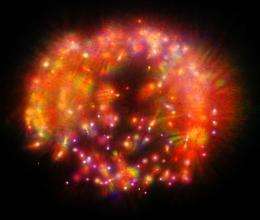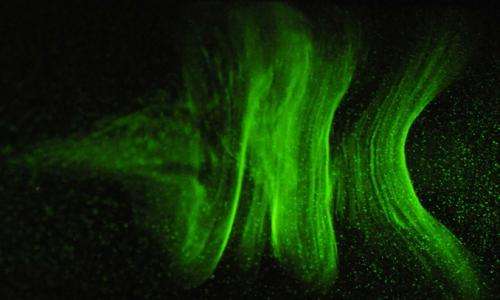July 16, 2012 feature
Scientists analyze potential of using lasers to make rain

(Phys.org) -- Although pointing high-energy lasers at the sky to cause pouring rain is currently a high-tech dream, the motivation behind controlling the weather has existed since the days of our ancient ancestors. Throughout human history, many civilizations developed magical or religious methods in an attempt to increase or decrease precipitation. In light of this history, current techniques that shoot laser beams or launch chemicals into the sky for the same purpose seem to be just the latest manifestation of this goal.
Nevertheless, these cloud seeding techniques are controversial, both for their effectiveness at inducing rainfall and for their possible harmful side effects. In a recent review paper published in the IOP’s Journal of Physics D: Applied Physics, a team of scientists from Switzerland and Germany has examined the latest results of laser-induced condensation and discussed the future of the field.
One of the first successful demonstrations of laser-induced condensation (http://www.nature.com/ncomms/journal/v2/n8/full/ncomms1462.html) came just last year, when researchers – including the authors of the current review – used a powerful laser to produce tiny water particles in moderately humid air. The water particles were just a few micrometers in diameter, which is about 100 times too small to fall as rain droplets. However, the experiments demonstrated the ability to transform particles in a gas phase to a liquid phase through condensation, and larger droplets are expected to be feasible.
“At this stage, our work clearly shows that lasers can induce the formation of tiny particles,” Jérôme Kasparian of the University of Geneva in Switzerland told Phys.org. “This is not, at least at this stage, efficient cloud seeding for making rain, but rather a newly opened direction for research in this direction.”

As the researchers explain in this review, laser-induced condensation owes its feasibility in part to the rapid improvement in laser power in recent years. Over the past decade, commercially available laser power has increased by two orders of magnitude, reaching the petawatt level today. Scientists expect laser powers on the exawatt scale in the foreseeable future. In last year’s demonstration, the researchers performed experiments using a 100-TW Draco laser and 5-TW mobile laser called Teramobile, which is the size of a 20-foot freight container.
In addition to more powerful lasers, improving the results will also require a better understanding of the underlying mechanism of laser-induced condensation. The technique involves photodissociation, in which photons break down atmospheric compounds in the atmosphere. This process produces ozone and nitrogen oxides, which lead to the formation of nitric acid particles that bind water molecules together to create water droplets. Understanding the details of how this process stimulates particle growth, as well as how atmospheric conditions affect the process, are the most challenging questions in this field, according to the scientists.
“Making rain would require first to have tiny water particles grow into droplets with a size sufficient to fall as raindrops,” Kasparian said. “This depends on the atmospheric conditions, in particular the relative humidity, that these particles will encounter. For example, if the air mass in which the particles have been produced lifts along a mountain hill, it will cool down and condensation will be favored.
“Making rain would also require the production of an adequate number density of particles. If there are too few particles, we would only get a few drops at most. On the other hand, if there are too many particles, they will compete with each other to grab the water molecules available in the atmosphere. Ultimately, none of them will grow sufficiently to make raindrops, which may even reduce precipitation.
“Finally, the technique would also need to activate a large volume of the atmosphere, i.e., to sweep the laser sufficiently fast.”
Despite these challenges, the scientists also noted that using lasers to induce rain has its advantages, particularly its minimal side effects compared to other techniques. For example, cloud seeding methods that involve injecting silver iodide particles into clouds run the risk of having unintended consequences for the surrounding atmosphere, a problem that lasers avoid. Laser-assisted methods also offer better control than chemical methods, since the lasers can be turned on and off and precisely positioned. This control also makes it easier to determine how effective the technique is, since critics often question whether rain might have occurred even without intervention.
In the future, the researchers recommend investigating the ability of lasers to seed clouds on a larger scale. Such a task will require further experimental data as well as theoretical modeling.
“Our aim now is to tackle the questions that remain open, especially to determine the optimal laser conditions to maximize the condensation process, and to assess for the possibility to obtain macroscopic quantities of condensed water,” Kasparian said. “This also requires an understanding of the physical mechanisms at the root of laser-induced condensation, with the ultimate goal of being able to model the process quantitatively.
“Besides the technical feasibility, as discussed above, further experiments will allow us to assess whether laser rainmaking could be cost-effective. This can easily be expressed in terms of the cost per unit rainwater volume obtained. This will depend very much on the ultimate laser power required to get a significant amount of water, which we need to further investigate.”
More information: J. Kasparian, et al. “Laser-assisted water condensation in the atmosphere: a step towards modulating precipitation?” J. Phys. D: Appl. Phys. 45 (2012) 293001 (13pp). DOI:10.1088/0022-3727/45/29/293001 http://iopscience.iop.org/0022-3727/45/29/293001
Journal information: Journal of Physics D: Applied Physics
Copyright 2012 Phys.org
All rights reserved. This material may not be published, broadcast, rewritten or redistributed in whole or part without the express written permission of PhysOrg.com.




















